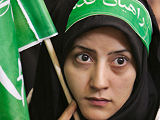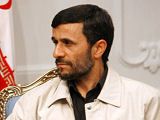5 Minute Guide: Iran
Updated on 23 December 2008
A rogue theocracy ruled by a controversial president? Or an ancient civilisation keen to be part of the nuclear age?
What's happened?
Iran is like nowhere else in the Middle East. For a start its culture is Persian not Arab, and it's the only country in the world where the overwhelming majority of people are Shia Muslims.
Britain has played a key role in Iran's history. The Anglo-Persian Oil Company operated as a state within a state, extracting oil and paying only a small royalty.
In 1951, Prime Minister Mohammed Mossadegh nationalised the oil. He was overthrown by a British and American-backed coup the following year.
The West's anxiety about the rise of Islam is rooted in the Iranian Revolution of 1979, which overthrew the American-backed Shah and brought Ayatollah Khomeini to power. Since then, the mullahs have ruled.
In the 1980s, Saddam Hussein started a war with his Persian neighbour but such was America's fear of revolutionary Islamic Iran, Washington backed Iraq.
Iran is accused of arming and funding the enemies of the USA and Israel, notably the militant group Hezbollah in Lebanon.
It is also accused of supporting Hamas in the Palestinian territories, and is on the US State Department list of state sponsors of terrorism.
Under President Mohammed Khatami, elected in 1997, Iran liberalised slightly, relaxing the dress code for women and allowing more debate.
But Mahmoud Ahmadinejad, elected in 2005 on a ticket of helping the poor, ushered in a new era of social conservatism and harsh anti-USA, anti-Israeli rhetoric.
In 2006, the UN Security Council imposed limited sanctions on Iran, suspecting it of building a nuclear weapon. Iran denied this, claiming its nuclear programme is for peaceful purposes.
Iran is accused of supporting Hamas in the Palestinian territories.
In March 2007, Iran was back in the spotlight after the capture of 15 British sailors and marines in the northern Gulf between Iraqi and Iranian waters.
The episode ended with an air of absurdity, after the 14 servicemen and one woman were released, flying to freedom in new suits complete with goodie bags that were "gifts" from the Iranian people.
Even stranger was Ahmadinejad's declaration later in the year, during his appearance at Columbia University in New York, that Iran didn't have gays like they did in the United States.
While in December of 2007 fears over Iran's nuclear programme subsided slightly when a new intelligence assessment was released in Washington showing that Iran was not, after all, trying to build a bomb.
However, the nuclear row was back on the agenda in 2008, when Ahmadinejad pledged that "the Iranian nation will not give up a single iota of its nuclear rights" in the face of threats of further UN sanctions.
There was more positive news when Ali Larijani, the speaker of the Iranian parliament, described Barack Obama as "more flexible and rational" than George Bush.
What does it mean?
President George Bush included Iran in his "axis of evil", alongside Iraq and North Korea, but the chances of an American invasion have diminished due to the Iraq war.
The US invasion of Iraq removed Iran's worst enemy, Saddam Hussein. This allowed the Persian country to extend its influence across the border into Iraq, where some 60 per cent of the population are Shia.
The Americans accuse Iran of arming groups attacking American soldiers.
Iran for it's part has remained resolute in the face of international opposition to its nuclear programme.
The country is still seen by many as the genuine opponent to globalisation and aggresive Americanism.
What happens next?

The current US administration refuses to hold negotiations with the government in Tehran.
However, as a major player in Iraq and Lebanon, and an historical enemy of Sunni Saudi Arabia, Iran will always play a crucial role in the Middle East.
Key players
Ayatollah Ali Khamanei
As Supreme Leader, Ayatollah Khamanei is the most powerful man in Iran. Decisions about the nuclear programme are ultimately in his hands.
An austere figure, he is not loved like his predecessor Ayatollah Khomeini. He is a Social Conservative.

Mahmood Ahmadinejad
Until his election as president in 2005, he was scarcely known even inside Iran. Since then, he has become a regular fixture on the world's TV screens, defying the West, promising to continue nuclear research, and even denying the Holocaust.
Yet he has far less power than the Supreme Leader, and his main impact has been to complicate Iran's relations with the West.
Akbar Hashemi Rafsanjani
The 72-year-old former president and great survivor of Iranian politics, is more of a pragmatist than an out-and-out reformer, but he is the most important opponent to the conservatives who control Iran.
He was elected as leader of the Assembly of Experts last year, a body which elects the Supreme Leader, Iran's most powerful post.
Mohammad Khatami
Known as Iran's first reformist president, he was in office from 1997 to 2005, but failed to make much headway against Conservative clerics.
Since the election of Ahmadinejad, some of his supporters have been jailed, and reformist newspapers have been closed down.



